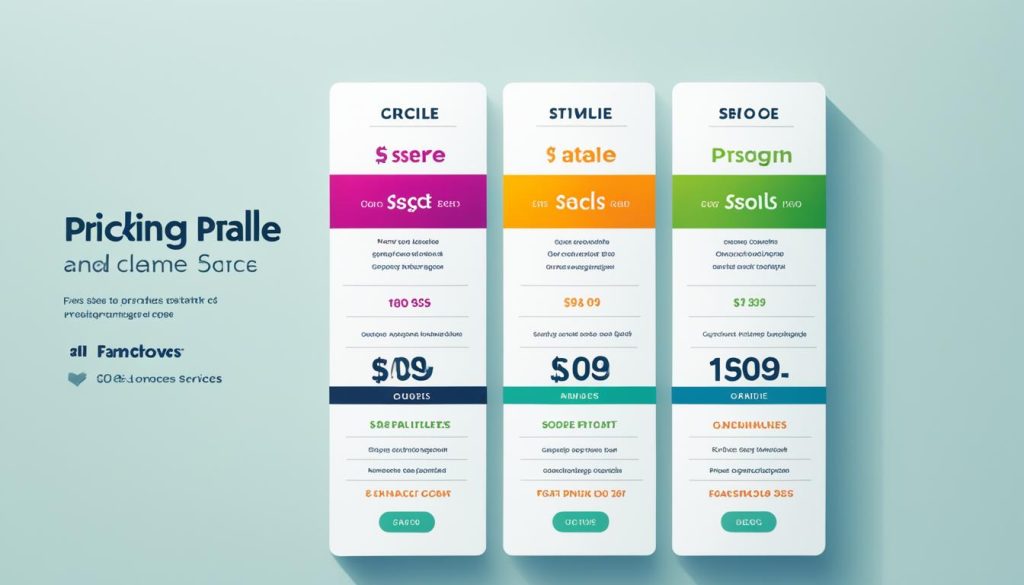The flat-rate pricing model is a compelling approach that offers benefits to both businesses and customers. It includes clear pricing and easy billing. This guide will help you understand flat-rate pricing. You’ll learn how to calculate it and how to use it in many industries. It will share examples from places like HVAC services and help you with common problems.
There are tools and software that make using flat-rate pricing easier and more profitable. FieldEdge Flat Rate and The New Flat Rate are two examples. These tools make managing flat-rate pricing simpler and more effective.
Key Takeaways
- Flat-rate pricing offers transparency and consistency in pricing.
- The guide covers the definition, calculation, and implementation of flat-rate pricing.
- Industry-specific examples such as HVAC services are spotlighted.
- Tools like FieldEdge Flat Rate and The New Flat Rate help manage pricing strategies.
- Common challenges and their solutions are also discussed.
What is Flat-Rate Pricing?
Flat-rate pricing sets a single cost for a service, no matter how much time or resources it needs. This way, customers know the exact price from the start. It covers all costs, making it clear and simple.
Customers like this because they know the total cost upfront. It also helps businesses sell their services more easily. With a flat-rate system, everyone understands the cost. This helps avoid hidden fees or sudden extra charges. It works especially well for service businesses.
Benefits of Flat-Rate Pricing
Switching to a flat-rate pricing model has many perks for both customers and companies. It makes billing clear and easy for everyone. This approach helps build trust and satisfaction on both sides.

For Customers
Flat-rate pricing advantages for customers include knowing the total price up front. This reduces worry about hidden fees. It also helps customers plan their budgets better. And, it makes customers trust the service provider more. So, people are likely to come back for more business.
For Businesses
Businesses, especially flat-rate pricing for small businesses, find stability in this system. It offers a chance to make more money by setting fixed prices. With no hourly rates, businesses avoid debates over labor costs. Since 92% of homeowners prefer this method, it shows how it makes customers happy. This leads to less arguing, which means better work flow and a better view of the business.
Flat-rate pricing helps companies handle billing better, cut costs on tracking time, and increase earnings. It’s the reason why many companies are moving to this system. And it makes both customers and businesses happy.
How to Implement Flat-Rate Pricing in Your Business
Flat-rate pricing can change how you handle service costs. It ensures every bill is the same, making customers happy. Let’s go through how to start this approach.
Calculating the Flat-Rate Price
First, find a solid flat-rate pricing formula. Look at everything that affects service costs to do this. The general formula includes these key points:
- Hourly Rate: Pick a base rate for each hour of work.
- Repair Time: Guess how long it usually takes to do a job.
- Parts Cost: Figure out the cost of all parts used in the job.
- Markup: Add extra to cover your business’s costs and make a profit.
By looking at these factors closely, companies can find a rate that’s both fair and competitive. That makes adding flat-rate pricing simple and helpful.
Setting Customer Expectations
Finding a flat-rate means being clear with customers about what they’re paying for. It’s important to lay out the scope of work straight away. This helps customers know what they’re in for. So, you should:
- Give a detailed list of what the flat rate covers.
- Explain any possible extra costs for surprises during the job.
- Let customers know how long the service will take.
Good communication leads to easy billing and happy clients. As you switch to flat-rate pricing, making costs clear and explaining things in advance will really help the plan succeed.
| Component | Details |
|---|---|
| Hourly Rate | Base rate charged per hour of service |
| Repair Time | Estimated average time to complete the job |
| Parts Cost | Expenses for required parts or materials |
| Markup | Additional costs added to cover overhead and ensure profit |
Flat-Rate Pricing Examples
Flat-rate pricing is used in many areas like the HVAC sector. It’s also seen in freelance work and subscriptions. We’ll take a closer look at these examples. This will help anyone looking to understand flat-rate pricing programs.

HVAC Services
HVAC companies use flat-rate pricing to make costs clear. This stops customers from worrying about unexpected bills. It makes paying simple and straight forward. Customers like knowing the price before any work begins.
Freelance Services
Designers and writers often choose fixed prices for their work. It helps them earn more while keeping things simple. A flat-rate pricing program guide shows them how to set fair prices. This keeps business steady and clients happy with clear costs.
Subscription Models
Digital papers and mail services also love flat-rate pricing. It makes their offers clear and easy to budget for. Since there are no surprise costs, clients stay happy. This helps build a strong and loyal customer base.
Here’s a table comparing different industries that use flat-rate pricing:
| Industry | Flat-Rate Pricing Benefits | Examples |
|---|---|---|
| HVAC Services | Eliminates unpredictability, ensures transparency | Standard repair costs, fixed maintenance fees |
| Freelance Services | Improves earnings efficiency, predictable income | Design projects, writing assignments |
| Subscription Models | Predictable pricing, high customer satisfaction | Digital newspapers, postal services |
Choosing the Right Flat-Rate Pricing Program
When picking a flat-rate pricing program, look at the tools offered. Make sure it meets your business needs. Tools such as FieldEdge and The New Flat Rate have features like big parts databases and daily price checks. They help businesses work smoothly and price jobs correctly to make a profit.
It’s good to know what these tools can do. This helps pick the best one for your business. Look for features like parts databases, daily price checks, and menu pricing options. These help boost your profits.
- Extensive parts databases
- Daily price monitoring
- Menu pricing options
- Profit-increasing service bundles
FieldEdge and The New Flat Rate are great for contractors. They offer up-to-date prices and suggestions for services. This keeps your business making money.

Here’s a detailed comparison of FieldEdge and The New Flat Rate to guide your decision-making process:
| Feature | FieldEdge | The New Flat Rate |
|---|---|---|
| Parts Database | Extensive, regularly updated | Comprehensive, frequently refreshed |
| Price Monitoring | Daily updates | Real-time analysis |
| Menu Pricing | Automated suggestions | Profit-boosting options |
| Service Bundles | Customizable bundles | Pre-configured for profitability |
Evaluate the features of these tools to choose the best one. The right program will make your pricing strategy competitive and customer-focused. Each tool has something special to offer.
Common Challenges with Flat-Rate Pricing
Flat-rate pricing can bring many problems. To be successful, businesses must handle these issues well. A big challenge is getting job estimates right. If the work scope is wrong, it can cost a lot of money.

It’s also important to keep customers happy with the set price. Defining what the project includes at the start is key. This stops problems when customers ask for more, avoiding confusing bills and fights. Make sure the customer knows exactly what they are getting before starting the work.
Here are common issues and how to fix them:
- Accurate Scope Estimation: Create a detailed process to make sure you don’t miss any job parts.
- Clear Communication: Talk through everything with the customer upfront to avoid issues later.
- Customer Education: Let customers know what they’re paying for and if any extra costs might come up.
- Regular Reviews: Check your prices often to keep up with changing costs.
Check out this table for a clear example of problems and their solutions:
| Challenge | Solution |
|---|---|
| Inaccurate Job Estimates | Use detailed checklists and past data to better predict job costs. |
| Managing Customer Expectations | Giving customers a clear, written plan can avoid later disagreements. |
| Handling Unforeseen Issues | Always have a plan for surprises and tell customers about extra costs up front. |
| Maintaining Profitability | Adjust prices regularly to keep up with inflation and rising costs. |
By knowing these challenges and ways to deal with them, you can keep customers happy and your business making money.
Tools and Software for Flat-Rate Pricing
Flat-rate pricing software helps businesses in many ways. It does the math for you, keeps part costs updated, and shows prices clearly to your techs. These tools make handling flat-rate pricing easy and fast.
Advantages of Using Software
When you use flat-rate pricing tools, you get accurate prices every time. This means no more mix-ups with your customers. It can also help you sell more and have happier customers. With this software, mistakes in pricing go way down, so your service costs are always right.
Popular Software Options
FieldEdge Flat Rate and The New Flat Rate are some top choices for flat-rate pricing. They have big parts databases, keep prices current, and show clear service options to customers. These tools can lift your sales and make your customers happier without the need for pushy sales tactics.
Alternatives to Flat-Rate Pricing
Businesses often search for alternatives to flat-rate pricing to fit their services better. One choice is the time and material pricing. This way, customers pay for the exact time and resources spent. Although it’s flexible, it can be hard to predict costs.

Dynamic pricing is another option. This means prices change based on demand or time. Companies use real-time data for the best prices. For example, Uber changes its prices to match the number of people wanting rides.
Tiered pricing is also worth considering. It offers different price points for various service levels. This helps meet different customer needs and budgets. It can make customers happier by offering options from basic to premium service levels.
Thinking about these alternatives to flat-rate pricing needs focus on the business goals. It also needs to look at the market and what the customers want. Here’s a table that compares the benefits of each pricing approach:
| Pricing Strategy | Key Features | Benefits |
|---|---|---|
| Time and Materials | Bills based on actual time and materials used. | Flexible and transparent cost structure. |
| Dynamic Pricing | Prices fluctuate based on demand and other factors. | Optimizes revenue through real-time price adjustments. |
| Tiered Pricing | Offers multiple service levels at different price points. | Caters to diverse customer needs and budgets. |
Choosing the right pricing model is key to business success. It must meet the company’s strategic goals, customer needs, and market conditions. By studying dynamic pricing strategies carefully, companies can pick the best one. This can lead to more profit and happier customers.
Conclusion
The flat-rate pricing system is a game-changer for businesses looking to simplify their billing. It makes customers happier. This guide explained what flat-rate pricing is, why it’s good for everyone, and how to use it. With flat-rate pricing, businesses can build trust and improve service.
For example, HVAC services and digital subscriptions show that anyone can use flat-rate pricing. Tools like FieldEdge Flat Rate and The New Flat Rate make setting prices easy. They cut down on manual work and help businesses earn more.
Flat-rate pricing can be tricky because predicting costs and setting clear expectations is hard. But, the rewards are often bigger. Good communication and pricing honesty are key to customer happiness. The right tools and software make it easier to manage flat-rate pricing obstacles.
This guide is a great help for businesses wanting to move to flat-rate pricing. By learning about the pros, cons, and tools, you can choose what’s best for your business. This choice can lead to more money and better operations.





0 Comments